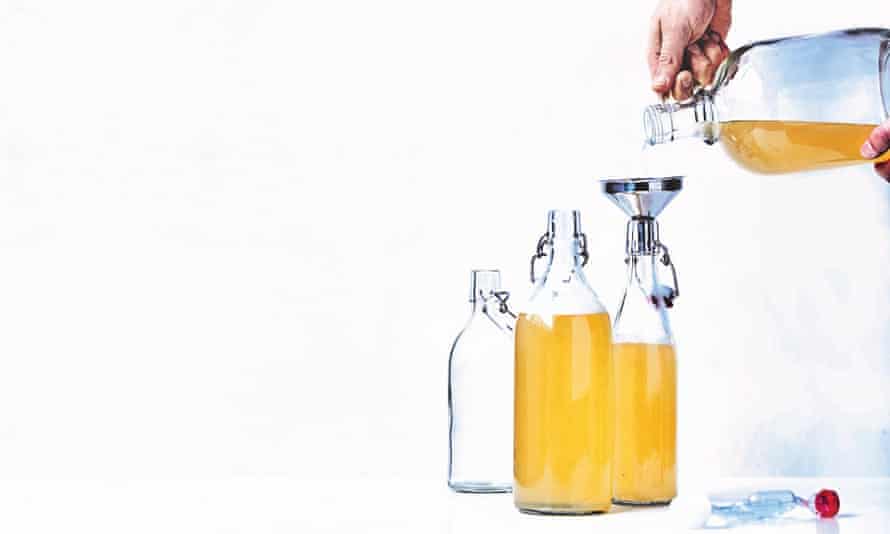Whether you harvest it non-alcoholic or leave it to become boozy over several months, home-brewed mead is a millennia-old tradition.
When making mead, choose artisan honey and be discerning about products made from a mixture of honey from different countries – read the label carefully.
The water should be around 25°C, in order for the honey to dissolve more easily. Be careful your water isn’t too warm or high in chlorine since this could kill the natural yeasts in the honey.
As with Ethiopian tej, you can add edible flowers to this drink at bottling stage. Try lavender, which goes very well with honey and gives the drink a Provençal flavour.
Recipe for Mead
Makes 1.5 litres (51 fl oz)
Prep 15 minutes
- 700g unpasteurised, unheated honey
- 1 litre bottled mineral water, filtered or decanted for 12 hours at room temperature before use
Originally posted :

Equipment
1 × 1.8L–2L sterilised, sealable jar (without lid)
1 long-handled stainless steel spoon
1 clean piece breathable fabric such as cheesecloth or linen
1 rubber band
1 funnel
2 × 750ml flip-top bottles
1 × 1.5L demijohn (carboy)
1 bubbler airlock (if making a more alcoholic version, see “option 2” below)
Method
Pour the honey into the jar, add the water and stir with the spoon until dissolved. Cover the jar with the cloth and secure with the rubber band. Set aside to ferment in a warm, dark place.
First fermentation
4–6 days
Stir the mixture every day until you start to see bubbles in it, which means that fermentation is under way. Keep tasting for the first six days, to get an idea of the drink’s flavours. When you notice a slight acidity developing, the drink is ready for harvesting.
It’s important to stir the mixture well at first fermentation stage in order to oxygenate the mead. The success of this spontaneous fermentation depends in large part on how much oxygen is available to the yeasts, so that they can multiply and work their magic.
Option 1: harvesting sweet, fizzy, non-alcoholic mead
1 week
Decant the drink into the flip-top bottles, being careful not to add the sediment. Set aside to ferment for one more week, releasing a little of the gas from the bottles every day.
Option 2: harvesting dry, lightly alcoholic mead
1–3 months
After the first ferment, pour the drink (but not the sediment) into a demijohn. Insert the bubbler airlock and set aside to ferment in a dark place for 1–3 months, until the bubbler airlock stops releasing bubbles. The longer fermentation lasts, the more alcoholic your mead will be. Decant the mead into the flip-top bottles, avoiding adding the sediment as before.
If you’re making a more alcoholic version, once your mead has been fermenting in the demijohn for a couple of months, it is highly likely that the yeasts inside will have used up all of the fermentable sugars. Try adding a teaspoon of sugar at bottling stage in order to get fermentation going again to guarantee a nice, fizzy result.
Set aside to ferment in the bottles for 1–2 weeks if you want the mead to be fizzy.
How will I know if it hasn’t worked?
If there are no bubbles.
When is it ready to drink?
When it has bubbles and a slightly sweet, not too sour flavour (this will vary according to the fermenting time).
1–3 months
After the first ferment, pour the drink (but not the sediment) into a demijohn. Insert the bubbler airlock and set aside to ferment in a dark place for 1–3 months, until the bubbler airlock stops releasing bubbles. The longer fermentation lasts, the more alcoholic your mead will be. Decant the mead into the flip-top bottles, avoiding adding the sediment as before.
If you’re making a more alcoholic version, once your mead has been fermenting in the demijohn for a couple of months, it is highly likely that the yeasts inside will have used up all of the fermentable sugars. Try adding a teaspoon of sugar at bottling stage in order to get fermentation going again to guarantee a nice, fizzy result.
Set aside to ferment in the bottles for 1–2 weeks if you want the mead to be fizzy.
How will I know if it hasn’t worked?
If there are no bubbles.
When is it ready to drink?
When it has bubbles and a slightly sweet, not too sour flavour (this will vary according to the fermenting time).
Kombucha, Kefir and Natural Sodas
This is an edited extract from Kombucha, Kefir and Natural Sodas by Nina Lausecker and Sebastian Landaeus.
